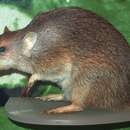tr
kırıntılardaki isimler


Golden bandicoots perceive their environment in many ways. Because they are nocturnal, they rely heavily on the ability to hear. Golden bandicoots also have an excellent sense of smell, which they use to find prey. They use their whiskers to feel around their environment. Additionally, they can see relatively well in the dark.
Perception Channels: visual ; tactile ; chemical
Golden bandicoots are considered vulnerable, and populations are decreasing for a variety of reasons. Predation by non-native species, especially by feral cats, is particularly damaging to populations. Golden bandicoots on Barrow and Middle Islands seem to have stable populations because few non-native species occupy these islands. Preventing the spread of feral cats to these islands is important for conservation of this species, especially on Barrow island, where the largest population of golden bandicoots occurs.
Change in fire regimes has also negatively affected populations of bandicoots. Golden bandicoots have no cover after a fire and are easily preyed upon by non-native predators.
In some areas, golden bandicoots also competete with non-native black rats.
CITES: no special status
There are no known adverse affects of golden bandicoots on humans.
Golden bandicoots can control insect populations that are considered pests by humans, such as cockroaches, termites and ants.
Positive Impacts: controls pest population
Golden bandicoots are important prey items to native and non-native predators. As a result of their diet, they control some insect populations that are considered pests by humans, such as cockroaches, termites and ants. Golden bandicoots also disperse seeds of certain plants they eat.
Ecosystem Impact: disperses seeds
Golden bandicoots are omnivorous. Their diet mainly consists of insects such as termites, ants and other arthropods. They also eat a variety of arachnid species. Golden bandicoots have been known to prey upon turtle eggs and small reptiles. Additionally, they consume plant material, usually consisting of seeds, roots, and tubers.
Animal Foods: reptiles; eggs; insects
Plant Foods: leaves; roots and tubers
Primary Diet: omnivore
Golden bandicoots, Isoodon auratus, are endemic to Australia. They were historically found throughout the interior of Australia but are currently restricted to very small areas of Western Australia and the Northern Territory. Additional populations exist on Barrow, Middle, Augustus, Marchinbar and Uwins Islands.
Biogeographic Regions: australian (Native )
Other Geographic Terms: island endemic
Golden bandicoots occupy a variety of habitats. They can be found in dry savannah habitats with an acacia or eucalyptus overstory, and they also colonize vine thickets. They occupy coastal scrub areas as well as rainforest margins and sometimes occupy rocky, sandstone and spinifex areas. Historically, golden bandicoots occurred throughout Australia in arid and semi-arid regions.
Habitat Regions: terrestrial
Terrestrial Biomes: desert or dune ; savanna or grassland ; scrub forest
Other Habitat Features: caves
Golden bandicoots have a relatively short life span in the wild, usually between 2 to 3 years.
Typical lifespan
Status: wild: 2 to 3 years.
Golden bandicoots are the smallest of the short nosed bandicoots, weighing between 300 and 670 g with measuring on average 350 mm in length. Males are generally larger than females. These marsupials have a compact body, sharp claws and a long nose. Their fur is brownish gold and is streaked with black on the upper and side parts of the body. The abdominal region and feet are a light amber color. The hairs of the fur are very course and stiff. The tail is long and sparsely haired. Golden bandicoots have rounded ears, and their eyes are very dark in color. They have a hunched overall body posture and are rat-like in appearance.
Range mass: 300 to 670 g.
Average length: 350 mm.
Sexual Dimorphism: male larger
Other Physical Features: endothermic ; bilateral symmetry
Predators of golden bandicoots mainly consist of non-native species that were introduced to Australia, such as red foxes and feral cats. Dingos and domestic dogs also prey upon golden bandicoots. Other native predators of golden bandicoots include reptiles such as pythons and monitor lizards, as well as northern quolls, scaley-tailed possoms and rock ringtail possums.
Known Predators:
Anti-predator Adaptations: cryptic
Little is known about the mating system of golden bandicoots.
Golden bandicoots breed throughout the year. Males and females mate briefly, and the male disperses after copulation. Gestation lasts about 2 weeks. Once the young are born they attach to one of their mother’s 8 teats inside her pouch. Offspring are very small when born, and litters consist of 2 to 4 individuals. Females nurse their young for about 8 weeks and can begin to mate shortly after the young have weaned. Juveniles become sexually mature around 3 months of age. Golden bandicoots reproduce as many times as they can during their short lives, and there is a significant increase in reproduction during seasons with high rainfall.
Breeding interval: Golden bandicoots can breed every 10 to 12 weeks.
Breeding season: Golden bandicoots breed throughout the year.
Range number of offspring: 2 to 4.
Average gestation period: 2 weeks.
Average weaning age: 8 weeks.
Average age at sexual or reproductive maturity (female): 3 months.
Average age at sexual or reproductive maturity (male): 3 months.
Key Reproductive Features: year-round breeding ; gonochoric/gonochoristic/dioecious (sexes separate); sexual ; viviparous
Male golden bandicoots disperse after copulation and do not contribute to raising offspring. Females provide milk to their young, which are weaned by 8 weeks of age.
Parental Investment: female parental care ; pre-hatching/birth (Provisioning: Female, Protecting: Female); pre-weaning/fledging (Provisioning: Female, Protecting: Female)